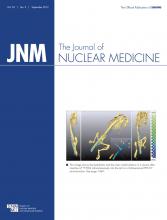Signaling pathways in cancer: Holland and colleagues review recent developments in targeting pharmacodynamic biomarkers that could utilize PET of signal transduction pathways in cancer and suggest new strategies for optimizing this potential.Page 1333
Axillary uptake in breast cancer: Song and colleagues determine standardized uptake values of metastatic axillary lymph nodes in patients with invasive ductal breast cancer to assess the pretreatment prognostic value of 18F-FDG PET/CT.Page 1337
Colorectal liver metastases and PET/CT: Muralidharan and colleagues look at the predictive utility of metabolic measurements derived from 18F-FDG PET before liver resection and compare this with other prognostic scoring systems.Page 1345
PET, PCC/PGL, and genotype: Rischke and colleagues explore the ability of 18F-DOPA PET to detect and stage pheochromocytomas/paragangliomas and ask whether specific genotypes correlate with tracer uptake.Page 1352

Response to 177Lu-octreotate therapy: van Vliet and colleagues compare the response of bone lesions with that of soft tissues to treatment with 177Lu-octreotate in patients with gastroenteropancreatic and bronchial neuroendocrine tumors.Page 1359
PET and brain metastases: Galldiks and colleagues investigate the potential of 18F-FET PET for differentiating local recurrent brain metastasis from radiation necrosis after radiation therapy.Page 1367

PET for temporal lobectomy: Theodore and colleagues assess the relative value of data from 5-HT1A PET and cerebral metabolic rate of glucose information from 18F-FDG PET for temporal lobectomy planning.Page 1375

FAA synthesis and lipid incorporation: Pichika and colleagues describe work with a stereoselective synthetic method for 19F-FAA and discuss its potential in PET imaging of human brain arachidonic metabolism in neuroinflammatory disorders such as Alzheimer disease.Page 1383
Rest–stress functional change: Karimi-Ashtiani and colleagues develop and validate a novel approach for automatic SPECT quantification of rest–stress myocardial motion and thickening changes.Page 1392
CZT MPI in obesity: Fiechter and colleagues evaluate the effect of increased body mass on myocardial perfusion imaging quality using a latest-generation γ-camera with cadmium-zinc-telluride semiconductor detectors in patients with high body mass indices.Page 1401
BAT activity in healthy men: Vrieze and colleagues use 18F-FDG PET/CT to examine the differential effects of an overnight fast and the postprandial state on brown adipose tissue activity.Page 1407

Age effects on serotonin receptors: Matuskey and colleagues use an 11C-labeled tracer and PET to determine whether the availability of brain serotonin receptor 5-HT1B decreases with aging in healthy adults.Page 1411
PET/MRI workflow: Martinez-Möller and colleagues provide an educational overview of considerations relating to workflow, imaging protocols, and image analysis for whole-body PET/MRI in oncology, based on early experience with an integrated PET/MRI scanner.Page 1415

Imaging lymph node metastases: Hall and colleagues develop and compare various dual-labeled monoclonal antibodies against the epithelial cell-adhesion molecule for both noninvasive and intraoperative detection of metastatic lymph nodes in prostate cancer.Page 1427
Positron lymphography: Thorek and colleagues investigate multimodal imaging in animal models using intradermal administration of 18F-FDG for combined diagnostic and intraoperative use, including the use of Cerenkov radiation to optically guide surgical resection of lymph nodes.Page 1438
Site-specific protein radiolabeling: Wållberg and colleagues describe a rapid technique for PET imaging of HER2-positive tumors in less than 1 h using a site-specific 11C-labeled Sel-tagged Affibody molecule.Page 1446
Predosing for ADCs: Boswell and colleagues evaluate in a mouse model a predosing strategy with unconjugated antibody to block antibody–drug conjugate uptake while preserving tumor uptake and efficacy.Page 1454
Amphiphile-encapsulated nanoparticles: Lee and colleagues develop and validate a method for modifying nanoparticles by encapsulation with specific ligand-conjugated amphiphiles and discuss the potential for multimodality and multispecific molecular imaging.Page 1462

18F-nifene kinetics: Hillmer and colleagues use both kinetic modeling and graphical analysis techniques to analyze the in vivo kinetic properties of this α4β2* nicotinic acetylcholine receptor agonist PET radioligand.Page 1471
Radiometals and sst2 antagonists: Fani and colleagues explore whether chelated somatostatin antagonists are sensitive to radiometal modifications and look at explanations for this sensitivity.Page 1481
SNMMI/ABNM statement on training: Delbeke and colleagues provide context for and full text of the SNMMI/American Board of Nuclear Medicine joint position statement on optimizing training in nuclear medicine in the era of hybrid imaging.Page 1490
ON THE COVER

This image shows the lymphatics and the main nodal stations in a mouse after injection of 18F-FDG intracutaneously into the tail in a 3-dimensional PET/CT reconstruction.
See page 1440.
- © 2012 by the Society of Nuclear Medicine and Molecular Imaging, Inc.







